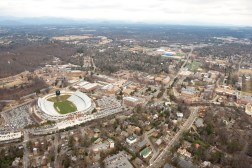How to improve IoT’s role in city construction? Model it from the start, a new report says

A new report sheds some light on the methods state and local government facilities can use to get the most out of the “internet of things” — particularly in the way internet-connected tools and appliances can coexist with retail, mixed-use, medical and governmental spaces.
The report looks at the ways that engineers can build the facilities of the future — smart buildings — while incorporating IoT devices from the very beginning of the virtual modeling process. The Georgia Tech Center for the Development and Application of Internet of Things Technologies, or CDAIT, produced the report, as a complement to a previous white paper about citizen engagement with IoT devices.
Smart cities — urban areas grouped by an often unclear label — are built around data as a means to optimize processes, even those residents are only passively aware of, like the lighting, heating and energy in buildings.
The sensors that the tech industry produces, though, are an “overlooked” aspect in the current architecture, engineering, construction, and operations industry, says one of the lead authors of the report, Dennis Shelden, director of Georgia Tech’s Digital Building Laboratory.
“Architecture is getting revolutionized by 3D models and virtual building of the design and construction of buildings,” Shelden told StateScoop. He said that incorporating the two sides of smart facilities — the 3D modeling of the actual construction, and the data streams constantly being collected by sensors — is the nascent challenge of the industry.
Building models have advanced from two-dimensional paper drawings to data-rich, virtual 3D renderings over the last two decades, the report notes. The new standard of modeling, known as building information systems, or BIM, has advanced to the point of being the “digital twin” of the built environment — able to provide enhanced context for IoT devices that will be used in the real building.
“We’re combining those two and understanding how to transfer information into these building models and digital simulations into the sensor side and back, while figuring out use cases where we can use that to solve problems of interest to state governments or educational campuses,” Shelden said.
The report features potential use cases of IoT technology, beginning with a “smart” screw gun that can count how many holes have been drilled and who is drilling the holes. It uses a fingerprint trigger lock, with the user’s cell phone serving as a data collector. The report also imagines a cyber-physical system that detects and visualizes real-time energy use, along with establishing a baseline energy consumption rate.
“We know how to use building models to understand how much concrete there is,” Shelden said, “and the building operators have similar information on utility information, how much it costs to heat a building or light a building, and using this approach, we think we can combine the two to give building operators a better idea of ‘if you’re gonna build a new building, what’s it going to cost up front, but also what’s it going to cost to run this thing over the life cycle.’ That’s one place where IoT and building-level information can come together.”
Shelden and his team are looking at continuing the research by using machine learning to evaluate the cost of a building throughout its life cycle. The information fed into the machine learning, the report notes, will be collected through IoT sensors.





